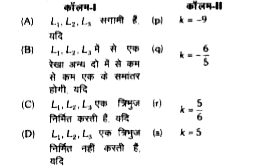∣∣ ∣ ∣∣(ax+a−x)2(ax−a−x)21(bx+b−x)2(bx−b−x)21(cx+c−x)2(cx−c−x)21∣∣ ∣ ∣∣
0
2abc
a2b2c2
इनमे से कोई नहीं
The correct Answer is:A
Step by step video, text & image solution for |((a^(x)+a^(-x))^(2),(a^(x)-a^(-x))^(2),1),((b^(x)+b^(-x))^(2),(b^(x)-b^(-x))^(2),1),((c^(x)+c^(-x))^(2),(c^(x)-c^(-x))^(2),1)| by Maths experts to help you in doubts & scoring excellent marks in Class 12 exams.
Topper's Solved these Questions
- BOOK - ERRORLESS HINDICHAPTER - सारणिक तथा आव्यूह EXERCISE - JEE ADVANCED MORE THAN ONE CORRECT ANSWERS66videos
सारणिक तथा आव्यूह
- BOOK - ERRORLESS HINDICHAPTER - सारणिक तथा आव्यूह EXERCISE - JEE ADVANCED MORE THAN ONE CORRECT ANSWERS (Comprehension type questions) (Passage-I)6videos
सारणिक तथा आव्यूह
- BOOK - ERRORLESS HINDICHAPTER - सारणिक तथा आव्यूह EXERCISE - Solved Multiple Choice Questions ( आव्यूह के प्रकार, आव्यूह का बीजगणित)130videos
सारणिक तथा आव्यूह
- BOOK - ERRORLESS HINDICHAPTER - सरल रेखा EXERCISE - JEE ADVANCE (Matrix Match type questions)4videos
सरल रेखा
Similar Questions
सारणिक ∣∣ ∣∣abaα+bbcbα+caα+bbα+c0∣∣ ∣∣=0 यदि
03:15View Solutionमाना कि p एक विषम अभाज्य संख्या है तथा Tp,2×2 आव्यूहों का निम्न समुच्चय है
Tp={A=[abca]:a,b,c∈{0,1,2,.............p−1}}
Tp में ऐसे A की संख्या जो सममित या विषम सममित अथवा दोनों प्रकार के हो एवं जिनके लिए det(A),p से विभाज्य है, निम्न है06:46View Solutionयदि M=[1223] और M2−λM−I2=0 तब λ=
05:15View Solution 04:08View Solution
04:08View SolutionShow that : xa(b−c)xb(a−c)⋅xbxa)c=1 (xa+b)2(xb+c)(xc+a)2(xaxbxc)4=1
03:46View SolutionIf g(x)=f(x)(x−a)(x−b)(x−c),where f(x) is a polynomial of degree <3 , then ∫g(x)dx=∣∣ ∣ ∣∣1af(a)log|x−a|1bf(b)log|x−b|1cf(c)log|x−c|∣∣ ∣ ∣∣÷∣∣ ∣ ∣∣1aa21bb21cc2∣∣ ∣ ∣∣+k dg(x)dx=∣[1,a,−f(a)(x−a)−2],[1,b,−f(b)(x−b)−2],[1,c,−f(c)(x−c)−2]∣∣ ∣ ∣∣−∣∣ ∣ ∣∣1aa21bb21cc2∣∣ ∣ ∣∣
11:18View SolutionIf ∣∣111abca3b3c3∣∣=(a−b)(b−c)(c−a)(a+b+c), then the solution of the equation ∣∣111(x−a)2(x−b)2(x−c)2(x−b)(x=−cx−c(x−a)(x−a)(x−b)∣=0is
03:22View Solutionif x2+x+1x2+2x+1=A+Bx+1+C(x+1)2 then A−B=
02:46View SolutionShow that: (i)xa(b−c)xb(a−c)÷(xbxa)c=1, (ii)(xa+b)2 (xb+c)2 (xc+a)2(xa xbxc)4=1
03:22View SolutionProve that.
(i) √x−1y.√y−1z.Sqrt(z−1x)=1
(ii) (1xa−b)1a−c.(1xb−c).(1xc−b)1c−b=1
(iii) xa(b−c)xb(a−c)÷(xbxa) (iv) (xa+b)2(xb+c)2(xc+a)2(xaxbxc)407:22View SolutionIf x2+x+1x2+2x+1=A+Bx+1+C(x+1)2 then A - B =
05:20View Solutionयदि x2+x+1x2+2x+1=A+Bx+1+C(x+1)2 तब A−B=
09:31View SolutionIf x2+x+1x2+2x+1=A+Bx+1+C(x+1)2 then A - B =
08:07View SolutionIf g(x)=f(x)(x−a)(x−b)(x−c),where f(x) is a polynomial of degree <3 , then ∫g(x)dx=∣∣ ∣ ∣∣1af(a)log|x−a|1bf(b)log|x−b|1cf(c)log|x−c|∣∣ ∣ ∣∣÷∣∣ ∣ ∣∣1aa21bb21cc2∣∣ ∣ ∣∣+k dg(x)dx=∣[1,a,−f(a)(x−a)−2],[1,b,−f(b)(x−b)−2],[1,c,−f(c)(x−c)−2]∣∣ ∣ ∣∣−∣∣ ∣ ∣∣1aa21bb21cc2∣∣ ∣ ∣∣
08:42View SolutionProve that: (xaxb)a2+ab+b2 × (xbxc)b2+bc+c2 × (xcxa)c2+ca+a2=1
View Solution|((a^(x)+a^(-x))^(2),(a^(x)-a^(-x))^(2),1),((b^(x)+b^(-x))^(2),(b^(x)-b^(-x))^(2),1),((c^(x)+c^(-x))^(2),(c^(x)-c^(-x))^(2),1)|
02:13View Solution

